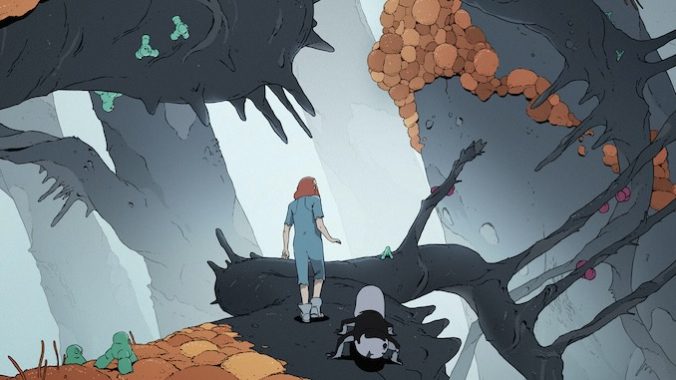Scavengers Reign’s Stellar Finale Cements It as True “Cozy Horror”
Photo Courtesy of Max

In the past couple months, I have quit posting on the site formerly known as Twitter, and have tried my best to avoid checking it. As such, I can’t say I’m as tuned in to the latest pointless nerd discourse as I used to be. However, one such much-debated topic from earlier this year is back on my mind now: the “cozy horror” discourse.
To recap what happened: a few writers tried to define a subgenre of “cozy horror”—fiction that contains dark supernatural elements but ultimately favors warm fuzzies over cold chills, citing works like Over the Garden Wall or What We Do in the Shadows as examples. People argued over whether such stories count as a type of “horror” as opposed to just pre-existing descriptors like “spooky” or “goth.” Then, an article from The Mary Sue tried to frame these genre classification arguments as hateful gatekeeping and brought in a weird gender essentialist angle, presenting traditional horror as “masculine” and “cozy horror” as “feminine,” and it became a whole big thing on Xitter for a few days.
I’m thinking about this discourse now after finishing the Max animated series Scavengers Reign, a show that stands out from basically every other American animated series in its commitment to actual no-bones-about-it terror—when it’s not basking in the splendor of its alien ecosystem in a manner that’s strangely relaxing. If “cozy horror” were an actual genre and it applied to full-blown adult horror as opposed to just comedies and softer-by-necessity children’s media, Scavengers Reign—particularly its ending—might fit the bill better than almost anything else.
Imagine if Ridley Scott’s Alien looked like James Cameron’s Avatar. Or if Hayao Miyazaki remade Annihilation. Or if a Planet Earth-style nature doc took place on another planet and the predators had human targets. That’s what Scavengers Reign feels like—the calmest and most beautiful possible delivery system for nightmares. This beautiful horror begins with its opening sequence, where pretty piano music makes a space disaster something you can watch again and again.
The show follows four humans and one robot who survived the crash of the spaceship Demeter (no Draculas involved in the crash, to be clear) on the planet Vesta. Commander Sam (Bob Stephenson) and botanist Ursula (Sunita Mani) landed together, and by the series’ start have already figured out how to make efficient use of the flora and fauna in their immediate area, but the further they travel, the stranger things get. Cargo specialist Azi (Wunmi Mosaku) is accompanied by the robot Levi (Alia Shawkat), which is developing sentience. Then there’s Kamen (Ted Travelstead), the man responsible for the crash in the first place; he is all alone except for a weird psychic creature called the Hollow feeding off his bad memories… and eventually, his body.
-

-

-

-

-

-

-

-

-

-

-

-

-

-

-

-

-

-

-

-

-

-

-

-

-

-

-

-

-

-

-

-

-

-

-

-

-

-

-

-








































